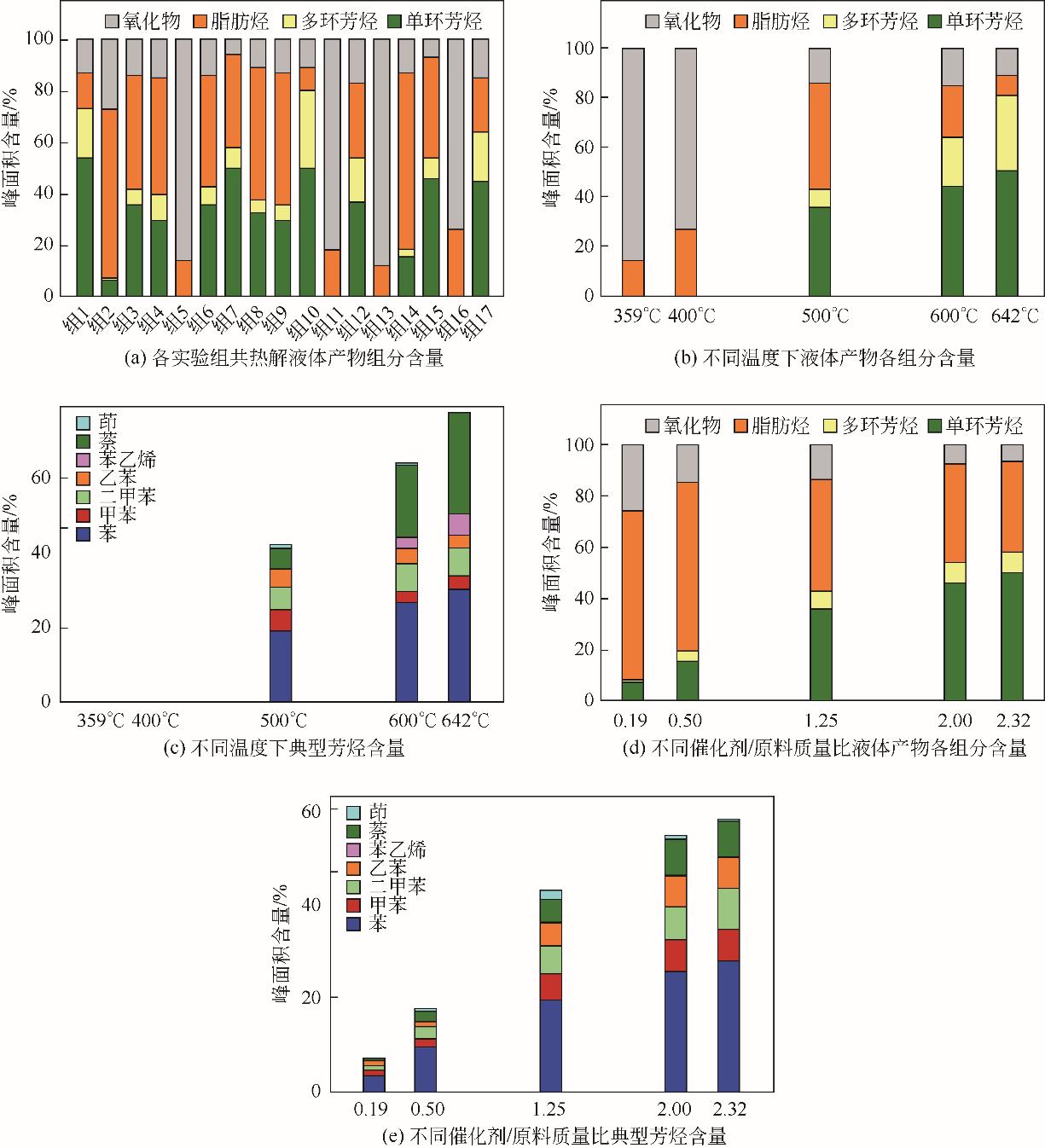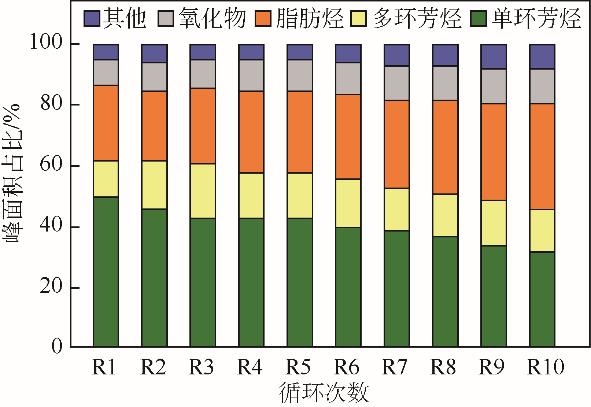| 1 |
WANG Z, BURRA K G, LEI T, et al. Co-pyrolysis of waste plastic and solid biomass for synergistic production of biofuels and chemicals—A review[J]. Progress in Energy and Combustion Science, 2021, 84: 100899.
|
| 2 |
KONAROVA M, ATANDA L, BATALHA N, et al. Hybridization of ZSM-5 with spinel oxides for biomass vapour upgrading[J]. ChemCatChem, 2020, 12(5): 1403-1412.
|
| 3 |
PERKINS G, BATALHA N, KUMAR A, et al. Recent advances in liquefaction technologies for production of liquid hydrocarbon fuels from biomass and carbonaceous wastes[J]. Renewable and Sustainable Energy Reviews, 2019, 115: 109400.
|
| 4 |
XIU S, SHAHBAZI A. Bio-oil production and upgrading research: a review[J]. Renewable and Sustainable Energy Reviews, 2012, 16(7): 4406-4414.
|
| 5 |
仉利, 姚宗路, 赵立欣, 等. 生物质热化学转化提质及其催化剂研究进展[J]. 化工学报, 2020, 71(8): 3416-3427.
|
|
ZHANG L, YAO Z L, ZHAO L X, et al. Research progress on preparation of high quality bio-oil by pyrolysis of biomass[J]. CIESC Journal, 2020, 71(8): 3416-3427.
|
| 6 |
BHOI P R, OUEDRAOGO A S, SOLOIU V, et al. Recent advances on catalysts for improving hydrocarbon compounds in bio-oil of biomass catalytic pyrolysis[J]. Renewable and Sustainable Energy Reviews, 2020, 121: 109676.
|
| 7 |
AHMED M H M, BATALHA N, MAHMUDUL H M D, et al. A review on advanced catalytic co-pyrolysis of biomass and hydrogen-rich feedstock: insights into synergistic effect, catalyst development and reaction mechanism[J]. Bioresource Technology, 2020, 310: 123457.
|
| 8 |
EPHRAIM A, MINH D P, LEBONNOIS D, et al. Co-pyrolysis of wood and plastics: influence of plastic type and content on product yield, gas composition and quality[J]. Fuel, 2018, 231: 110-117.
|
| 9 |
GUNASEE S D, CARRIER M, GORGENS J F, et al. Pyrolysis and combustion of municipal solid wastes: evaluation of synergistic effects using TGA-MS[J]. Journal of Analytical and Applied Pyrolysis, 2016, 121: 50-61.
|
| 10 |
MISHRA R K, MOHANTY K. Co-pyrolysis of waste biomass and waste plastics (polystyrene and waste nitrile gloves) into renewable fuel and value-added chemicals[J]. Carbon Resources Conversion, 2020, 3: 145-155.
|
| 11 |
YE X, LU Q, WANG X, et al. Catalytic fast pyrolysis of cellulose and biomass to selectively produce levoglucosenone using activated carbon catalyst[J]. ACS Sustainable Chemistry & Engineering, 2017, 5(11): 10815-10825.
|
| 12 |
ZHANG D, LIN X, ZHANG Q, et al. Catalytic pyrolysis of wood-plastic composite waste over activated carbon catalyst for aromatics production: effect of preparation process of activated carbon[J]. Energy, 2020, 212: 118983.
|
| 13 |
张东红, 任夏瑾, 蔡红珍, 等. 生物质/塑料共催化热解过程中HZSM-5失活分析[J]. 化工进展, 2021, 40(8): 4259-4267.
|
|
ZHANG D H, REN X J, CAI H Z, et al. Deactivation of HZSM-5 during the catalytic co-pyrolysis of biomass and plastic[J]. Chemical Industry and Engineering Progress, 2021, 40(8): 4259-4267.
|
| 14 |
LAM E, LUONG J H T. Carbon materials as catalyst supports and catalysts in the transformation of biomass to fuels and chemicals[J]. ACS Catalysis, 2014, 4(10): 3393-3410
|
| 15 |
LIN X, LEI H, HUO E, et al. Enhancing jet fuel range hydrocarbons production from catalytic co-pyrolysis of Douglas fir and low-density polyethylene over bifunctional activated carbon catalysts[J]. Energy Conversion and Management, 2020, 211: 112757.
|
| 16 |
MATEO W, LEI H, VILLOTA E, et al. Synthesis and characterization of sulfonated activated carbon as a catalyst for bio-jet fuel production from biomass and waste plastics[J]. Bioresource Technology, 2020, 297: 122411.
|
| 17 |
WANG X B, YANG S Q, XU C, et al. Effect of boron doping on the performance of Ni/biochar catalysts for steam reforming of toluene as a tar model compound[J]. Journal of Analytical and Applied Pyrolysis, 2021, 155: 105033.
|
| 18 |
JIA Y, HU R, ZHOU Q, et al. Boron-modified activated carbon supporting low-content Au-based catalysts for acetylene hydrochlorination[J]. Journal of Catalysis, 2017, 348: 223-232.
|
| 19 |
ZHOU G, LI J, YU Y, et al. Optimizing the distribution of aromatic products from catalytic fast pyrolysis of cellulose by ZSM-5 modification with boron and co-feeding of low-density polyethylene[J]. Applied Catalysis A: General, 2014, 487: 45-53.
|
| 20 |
ROMANOS J, BECKNER M, STALLA D, et al. Infrared study of boron-carbon chemical bonds in boron-doped activated carbon[J]. Carbon, 2013, 54: 208-214.
|
| 21 |
GANIYU S A, AJUMOBI O O, LATEEF S A, et al. Boron-doped activated carbon as efficient and selective adsorbent for ultra-deep desulfurization of 4, 6-dimethyldibenzothiophene[J]. Chemical Engineering Journal, 2017, 321: 651-661.
|
| 22 |
DUAN D, ZHANG Y, WANG Y, et al. Production of renewable jet fuel and gasoline range hydrocarbons from catalytic pyrolysis of soapstock over corn cob-derived activated carbons[J]. Energy, 2020, 209: 118454.
|
| 23 |
BHOI P R, OUEDRAOGO A S, SOLOIU V, et al. Recent advances on catalysts for improving hydrocarbon compounds in bio-oil of biomass catalytic pyrolysis[J]. Renewable and Sustainable Energy Reviews, 2020, 121: 109676.
|
| 24 |
XUE Y, KELKAR A, BAI X. Catalytic co-pyrolysis of biomass and polyethylene in a tandem micropyrolyzer[J]. Fuel, 2016, 166: 227-236.
|
| 25 |
林晓娜, 雷寒武, 易维明, 等. 活性炭催化生物质与低密度聚乙烯共热解[J]. 农业工程学报, 2021, 37(15): 189-196.
|
|
LIN X N, LEI H W, YI W M, et al. Catalytic co-pyrolysis of biomass and low-density polyethylene over activated carbon catalyst [J]. Transactions of the Chinese Society of Agricultural Engineering, 2021, 37(15): 189-196.
|
| 26 |
DUAN D, ZHANG Y, LEI H, et al. Renewable jet-fuel range hydrocarbons production from co-pyrolysis of lignin and soapstock with the activated carbon catalyst[J]. Waste Management, 2019, 88: 1-9.
|
| 27 |
OCHOA A, BILBAO J, GAYUBO A G, et al. Coke formation and deactivation during catalytic reforming of biomass and waste pyrolysis products: a review[J]. Renewable and Sustainable Energy Reviews, 2020, 119: 109600.
|
| 28 |
惠贺龙, 李松庚, 宋文立. 生物质与废塑料催化热解制芳烃(Ⅰ): 协同作用的强化[J]. 化工学报, 2017, 68(10): 3832-3840.
|
|
HUI H L, LI S G, SONG W L. Aromatic hydrocarbon from catalytic pyrolysis of biomass and plastic wastes (Ⅰ): Enhancing synergistic effect [J]. CIESC Journal, 2017, 68(10): 3832-3840.
|
| 29 |
WANG J, JIANG J, DING J, et al. Promoting Diels-Alder reactions to produce bio-BTX: co-aromatization of textile waste and plastic waste over USY zeolite[J]. Journal of Cleaner Production, 2021: 127966.
|
| 30 |
XU D, YANG S, SU Y, et al. Simultaneous production of aromatics-rich bio-oil and carbon nanomaterials from catalytic co-pyrolysis of biomass/plastic wastes and in-line catalytic upgrading of pyrolysis gas[J]. Waste Management, 2021, 121: 95-104.
|
| 31 |
ZHANG Y, LEI H, YANG Z, et al. Renewable high-purity mono-phenol production from catalytic microwave-induced pyrolysis of cellulose over biomass-derived activated carbon catalyst[J]. ACS Sustainable Chemistry & Engineering, 2018, 6(4): 5349-5357.
|
 ), 郭亚东1,2, 邸璐1,2, 毕冬梅1,2, 李凯凯1, 林晓娜1,2(
), 郭亚东1,2, 邸璐1,2, 毕冬梅1,2, 李凯凯1, 林晓娜1,2( )
)
 ), GUO Yadong1,2, DI Lu1,2, BI Dongmei1,2, LI Kaikai1, LIN Xiaona1,2(
), GUO Yadong1,2, DI Lu1,2, BI Dongmei1,2, LI Kaikai1, LIN Xiaona1,2( )
)






